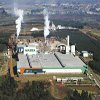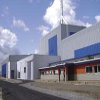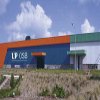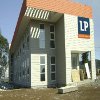LP Bazil leads the way in OSB development
11 February 2010Despite the global economic crisis, the US giant, which launched the region’s first OSB mill in Chile five years ago, expects the panel will be in common structural use in Brazil in a little over three years’ time.
Only last year, LP South America established a powerful bridgehead in the region’s biggest country when it negotiated a complex deal to acquire Masisa SA’s 350,000m3/year continuous Dieffenbacher OSB line at Ponta Grossa.
In the longer term, LP aims to repeat in Brazil the OSB development process it employed in Chile with such success. That has seen two separate Chilean plants established – with one handling speciality OSB construction products – and rapid growth in the local market.
Today, LP Brazil is still focused on establishing the concept of wood frame housing in Brazil using OSB panels and on switching existing output at Ponta Grossa to structural products.
Strangely, economic pressures locally have helped the LP cause as house builders and the Brazilian authorities seek new technology to lower construction costs, says LP South America’s general manager Frederick Price, a pioneer of OSB development in the region.
“We are working to increment the demand for housing applications in Brazil... It’s going at a speed that’s good for us ...We are seen as a cheaper option. The [global] crisis is very bad, but it can still have a good side,he told WBPI in a recent interview in Brazil.
If the market grows in the long term, as LP hopes, the company aims to take advantage of its ‘new’ continuous line to concentrate volume OSB panel output at Ponta Grossa. Then it plans to launch a separate batch-press line, primarily to make siding and other speciality OSB products, elsewhere in Brazil, confirmed Mr Price.
The Anglo-Chilean executive is confident he will be able to sell around 70% of LP Brazil’s production in the huge Brazilian market after three years.
In July 2009, however, when WBPI visited LP in Ponta Grossa, the firm said the Dieffenbacher line was producing less than 40% of its total capacity in the face of the recession.
LP recognises that, while Masisa adopted a different approach to OSB production based on its furniture sector background, it did build up valuable local experience and created some promising OSB niche products.
But the US group only expects to continue producing around half the products that make up Masisa’s 10,000m3/month output. The company prefers to mainstream with the more familiar construction business.
“Some part of the Masisa legacy will remain with us in the future. We will continue about half the volume it was doing. The rest, we feel, doesn’t have a life,said Mr Price.
His company aims to keep, for example, Masisa’s low-priced ‘Tapume’ board, used for building site hoardings; some of the heavy duty packaging products; and a new, stronger, version of the 22mm-thick ‘Ecotabua’OSB plank product used for construction walkways or table tops.
However, it is the construction potential for OSB that has attracted LP to move on to Brazil. With the national population due to soar by 41 million over the next 20 years
– and Brazil’s current housing deficit of an estimated 8 million homes – OSB seems to have a bright future there.
The decision to jump into the region’s biggest marketplace is a signal to South
America and beyond that the US forest products giant is committed to the region, stressed Mr Price.
The Brazilian plan is based on LP’s Chilean blueprint. The group came to Chile with OSB technology and set about ‘converting’ the construction industry to the new wood frame system creed.
It was not just a matter of selling to a new market, but “an educational thing”. Offering a mix of the right products, a competitive price, training and the right marketing, LP won over a receptive Chilean building sector. To date, the firm has trained around 7,000 carpenters overall to use OSB, explained the general manager.
The revolution in Chile, where 30% of new homes now use the wood frame construction system, was the result of a team effort between the OSB supplier, roofing providers and suppliers of metal structures, engineers and construction firms. In the space of a year, recalled Mr Price, the whole building system changed in Chile.
Today, around 90% of all social housing projects across Chile make use of OSB in construction, whereas four years back, usage was virtually zero, remembered another veteran of the campaign, LP South America’s operations manager Victor Flores.
He and Frederick Price were pioneers of OSB in Latin America when both were at the LP Chile predecessor Bomasil. It produced first panel at what is now LP’s Panguipulli mill in the Valdivia region in June 2001, recalled Mr Flores.
In early 2008, with OSB demand growing rapidly in Chile, group offshoot LP Chile brought on-stream its second national plant, 80 miles north of Panguipulli at Lautaro.
The ramp-up was rapid for the new 150,000m3/year batch-press line, which includes a modified secondhand press, formerly at LP’s US site in Montrose, Colorado.
But as the world crisis deepened, the market finally collapsed in November 2008 and the Lautaro mill, which had reached a capacity of 105,000m3/year, was closed in December pending an economic recovery.
In September 2009, LP was preparing to take a decision on where the South American operations should go next. Depending on market development it would either boost Brazilian production or restart the Lautaro mill.
Since then, the economic picture has brightened somewhat and the group hoped to relaunch the Chilean mill in January this year. Timing of a restart is important as mills must buy the necessary wood supply through the summer months – that is from November to March – to allow operation during that year.
The Lautaro start-up will rely on wood already acquired by LP in 2008 – and any it could buy in November and December 2009 – and production may be intermittent, with possible closure again from May to September 2010 and another re-start later, Mr Price warned when he updated WBPI in December 2009.
Once the Lautaro mill is fully operating again, the ultimate aim is for it to export around 50% of its overall output. While LP Chile sells some products to Brazil, other OSB is exported to countries including Argentina and Peru, the latter buying roofing and packaging products as well as shortterm housing components used to provide shelter for the mining sector.
Back in Brazil, LP plant managers and office staff have been settling in to their newly completed office block, located on the Ponta Grossa site that LP’s OSB plant still shares with Masisa’s MDF panel making operation.
The unique US$230,000 office building, designed by LP Brazil’s export manager, also a qualified architect, is constructed using a range of LP products and doubles as a showroom for LP clients.
What is extraordinary about the Ponta Grossa site today is that a ‘frontier’ has been established, passing right through the heart of the original Masisa operation. On one side are silos and machinery halls in the green livery of Masisa, while across the line stand buildings in the orange and blue style of LP South America.
On the split site, LP manages most of the ‘vital fluids’ of the two mills, including the thermal oil facility, the railhead which delivers wood to both lines and the woodyard. Executives at other Brazilian panel companies are still puzzled that teams from separate businesses can survive so close together.
But, after eight months of cooperation, it seems managers and workers from each plant have established a smooth relationship and avoided treading on each others’ toes.
While LP South America has not escaped the ill effects of the global crisis, it is clear that the company, along with Masisa, has played a big part in creating an OSB market in the region.
Certainly the original pioneers, like Frederick Price, are justly proud of their role in transforming the housing technology in large parts of the subcontinent.
Despite the global economic crisis, the US giant, which launched the region’s first OSB mill in Chile five years ago, expects the panel will be in common structural use in Brazil in a little over three years’ time.
Only last year, LP South America established a powerful bridgehead in the region’s biggest country when it negotiated a complex deal to acquire Masisa SA’s 350,000m3/year continuous Dieffenbacher OSB line at Ponta Grossa.
In the longer term, LP aims to repeat in Brazil the OSB development process it employed in Chile with such success. That has seen two separate Chilean plants established – with one handling speciality OSB construction products – and rapid growth in the local market.
Today, LP Brazil is still focused on establishing the concept of wood frame housing in Brazil using OSB panels and on switching existing output at Ponta Grossa to structural products.
Strangely, economic pressures locally have helped the LP cause as house builders and the Brazilian authorities seek new technology to lower construction costs, says LP South America’s general manager Frederick Price, a pioneer of OSB development in the region.
“We are working to increment the demand for housing applications in Brazil... It’s going at a speed that’s good for us ...We are seen as a cheaper option. The [global] crisis is very bad, but it can still have a good side,he told WBPI in a recent interview in Brazil.
If the market grows in the long term, as LP hopes, the company aims to take advantage of its ‘new’ continuous line to concentrate volume OSB panel output at Ponta Grossa. Then it plans to launch a separate batch-press line, primarily to make siding and other speciality OSB products, elsewhere in Brazil, confirmed Mr Price.
The Anglo-Chilean executive is confident he will be able to sell around 70% of LP Brazil’s production in the huge Brazilian market after three years.
In July 2009, however, when WBPI visited LP in Ponta Grossa, the firm said the Dieffenbacher line was producing less than 40% of its total capacity in the face of the recession.
LP recognises that, while Masisa adopted a different approach to OSB production based on its furniture sector background, it did build up valuable local experience and created some promising OSB niche products.
But the US group only expects to continue producing around half the products that make up Masisa’s 10,000m3/month output. The company prefers to mainstream with the more familiar construction business.
“Some part of the Masisa legacy will remain with us in the future. We will continue about half the volume it was doing. The rest, we feel, doesn’t have a life,said Mr Price.
His company aims to keep, for example, Masisa’s low-priced ‘Tapume’ board, used for building site hoardings; some of the heavy duty packaging products; and a new, stronger, version of the 22mm-thick ‘Ecotabua’OSB plank product used for construction walkways or table tops.
However, it is the construction potential for OSB that has attracted LP to move on to Brazil. With the national population due to soar by 41 million over the next 20 years
– and Brazil’s current housing deficit of an estimated 8 million homes – OSB seems to have a bright future there.
The decision to jump into the region’s biggest marketplace is a signal to South
America and beyond that the US forest products giant is committed to the region, stressed Mr Price.
The Brazilian plan is based on LP’s Chilean blueprint. The group came to Chile with OSB technology and set about ‘converting’ the construction industry to the new wood frame system creed.
It was not just a matter of selling to a new market, but “an educational thing”. Offering a mix of the right products, a competitive price, training and the right marketing, LP won over a receptive Chilean building sector. To date, the firm has trained around 7,000 carpenters overall to use OSB, explained the general manager.
The revolution in Chile, where 30% of new homes now use the wood frame construction system, was the result of a team effort between the OSB supplier, roofing providers and suppliers of metal structures, engineers and construction firms. In the space of a year, recalled Mr Price, the whole building system changed in Chile.
Today, around 90% of all social housing projects across Chile make use of OSB in construction, whereas four years back, usage was virtually zero, remembered another veteran of the campaign, LP South America’s operations manager Victor Flores.
He and Frederick Price were pioneers of OSB in Latin America when both were at the LP Chile predecessor Bomasil. It produced first panel at what is now LP’s Panguipulli mill in the Valdivia region in June 2001, recalled Mr Flores.
In early 2008, with OSB demand growing rapidly in Chile, group offshoot LP Chile brought on-stream its second national plant, 80 miles north of Panguipulli at Lautaro.
The ramp-up was rapid for the new 150,000m3/year batch-press line, which includes a modified secondhand press, formerly at LP’s US site in Montrose, Colorado.
But as the world crisis deepened, the market finally collapsed in November 2008 and the Lautaro mill, which had reached a capacity of 105,000m3/year, was closed in December pending an economic recovery.
In September 2009, LP was preparing to take a decision on where the South American operations should go next. Depending on market development it would either boost Brazilian production or restart the Lautaro mill.
Since then, the economic picture has brightened somewhat and the group hoped to relaunch the Chilean mill in January this year. Timing of a restart is important as mills must buy the necessary wood supply through the summer months – that is from November to March – to allow operation during that year.
The Lautaro start-up will rely on wood already acquired by LP in 2008 – and any it could buy in November and December 2009 – and production may be intermittent, with possible closure again from May to September 2010 and another re-start later, Mr Price warned when he updated WBPI in December 2009.
Once the Lautaro mill is fully operating again, the ultimate aim is for it to export around 50% of its overall output. While LP Chile sells some products to Brazil, other OSB is exported to countries including Argentina and Peru, the latter buying roofing and packaging products as well as shortterm housing components used to provide shelter for the mining sector.
Back in Brazil, LP plant managers and office staff have been settling in to their newly completed office block, located on the Ponta Grossa site that LP’s OSB plant still shares with Masisa’s MDF panel making operation.
The unique US$230,000 office building, designed by LP Brazil’s export manager, also a qualified architect, is constructed using a range of LP products and doubles as a showroom for LP clients.
What is extraordinary about the Ponta Grossa site today is that a ‘frontier’ has been established, passing right through the heart of the original Masisa operation. On one side are silos and machinery halls in the green livery of Masisa, while across the line stand buildings in the orange and blue style of LP South America.
On the split site, LP manages most of the ‘vital fluids’ of the two mills, including the thermal oil facility, the railhead which delivers wood to both lines and the woodyard. Executives at other Brazilian panel companies are still puzzled that teams from separate businesses can survive so close together.
But, after eight months of cooperation, it seems managers and workers from each plant have established a smooth relationship and avoided treading on each others’ toes.
While LP South America has not escaped the ill effects of the global crisis, it is clear that the company, along with Masisa, has played a big part in creating an OSB market in the region.
Certainly the original pioneers, like Frederick Price, are justly proud of their role in transforming the housing technology in large parts of the subcontinent.



